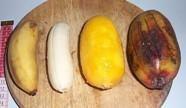
The New Scientist has reported on a new strain of orange banana, which it is hoped will assist in the prevention of blindness in young children.
The following is an extract from the article:
“It looks like a fat carrot, but it is actually a banana. And it is so rich in precursors to vitamin A that researchers hope it could prevent children from going blind in the Pacific islands of Micronesia.
“Dubbed the "karat" because of its bright orange flesh, the unusual banana has been used for centuries in Micronesia to wean infants onto solid food. But today it is rarely eaten there, as imported foods have grown in popularity.
“That now looks set to change. A screening programme sponsored by the agriculture ministry of Pohnpei, a Micronesian island, has established that the karat is unusually rich in beta-carotene, which the body converts into vitamin A.
“The hope is that the fruit could now be routinely given to children deficient in this vitamin, to help them avoid developing certain kinds of blindness.
“Lois Englberger of the Island Food Community of Pohnpei and Adelino Lorens of the Pohnpei ministry of agriculture screened 21 cultivars of native banana all selected for their deeply hued yellow, orange or red flesh, a result of high levels of carotenoids.
“They found that 15 of them contained enough carotenoids to supply half of the recommended daily intake of vitamin A, if consumed as part of a typical diet. The karat was the most promising cultivar studied, and had more than 25 times as much beta-carotene as the traditional Cavendish banana.
“Steam-boiling karats makes more carotenoids available to the body. But they can also be eaten ripe and raw, says Englberger, who presented her findings this week in Penang, Malaysia, at an international conference on bananas and plantains.”



